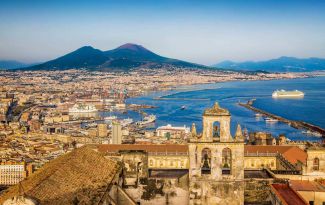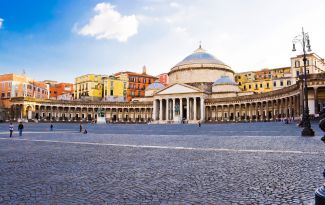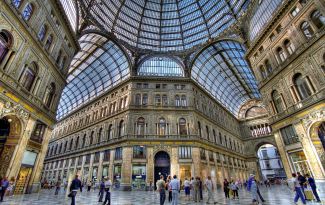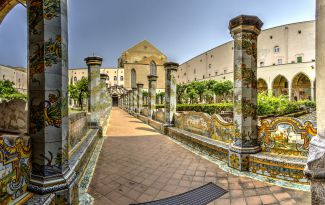The biggest open-air museum in the world
Naples is one of the most beautiful cities in Italy due to its location, natural beauty, and richness, and is considered the wonder of Italy by many. This typical Southern Italian city is surrounded by the Gulf of Naples, the Campi Flegrei mountain range, and Mount Vesuvius. The city of Naples overlooks the sea with the Capri's island in the background. At the end of the beach stands the Castel dell'Ovo fortress on a rocky peninsula, and many charming hotels can be found along it.
Naples is a city where you can experience a myriad of emotions thanks to the natural beauty of the landscape as well as its rich history and culture. Among the many attractions, there are Piazza Municipio, Maschio Angioino Castle, the famous Plebiscito Square, the Royal Palace, and the San Francesco di Paola Basilica.
During your visit to Naples, the following attractions are highly recommended: Teatro San Carlo, Santa Chiara Monastery, Naples Cathedral, Castel Sant'Elmo, Castel dell'Ovo, the main street Spaccanapoli, and the streets Via Caracciolo, San Gregorio Armeno, and San Biagio dei Librai.
The Largest Historical Center in Europe
The center of Naples consists of two parts: the first part, Pizzofalcone, originates from Partenope's city. The other part of Naples is Neapolis, that is a home to many historical buildings from the Greek and Roman times, including obelisks, monasteries, museums, catacombs, many underground and outdoor attractions such as preserved ancient theaters. The city is characterized mainly by its numerous churches (around 300), which host an impressive artistic legacy from renowned artists including Caravaggio, Donatello, Giuseppe Sanmartino, Luca Giordano, and Cosimo Fanzago. The city also houses a large number of tombs of important rulers who succeeded each other over the centuries.
According to experts, the number of religious buildings in Naples exceeds 400, including neglected churches that no longer serve a purpose, but excluding modern structures.
Naples Cathedral
The Cathedral of Santa Maria Assunta, better known as the Cathedral of San Gennaro, is one of the most important churches in Naples. It was built on a site where two temples dedicated to Apollo and Neptune once stood. This church is undoubtedly one of the highlights of Naples. It has one of the oldest baptismal chapels in the Western world, which also contains the Gothic masterpiece, a golden bust of Saint Gennaro.
The Miracle of San Gennaro
In 305, the bishop of Benevento, named San Gennaro, fled to Naples to escape from Christian persecution under Emperor Diocletian. In Naples, he was eventually beheaded by a Roman ruler. A devout woman collected his blood in two ampoules, which were later lost. A century later, in 431, these ampoules were found by another woman, who then showed them to a bishop. The evidence that these ampoules contained the blood of San Gennaro was that the coagulated blood became liquid when the bishop looked at it. Every year in Naples, on the first Sunday of May, on September 19th (the day of San Gennaro's beheading), and on December 16th (the day the blood became liquid), a ceremony is held in which the coagulated blood becomes liquid again. For six hundred years, the annual liquefaction of San Gennaro's blood has symbolized a blessing for the city of Naples.
Archaeological Museum
The National Archaeological Museum in Naples is one of the most important archaeological museums in Europe. This museum houses many remains from Pompeii, as well as treasures from ancient Egypt. Numerous bronze and marble statues, casts, paintings, and objects of craftsmanship have been brought together here from the excavations in Cuma. The museum also features materials from the Borgia collection of Etruscan and Egyptian antiquities, and an ancient Santagelo coin collection.
Naples Underground
A visit to Naples Underground is an absolute must. It's an experience that changes forever the way you look at the city and it makes the history of "Partenope" clearly visible. Beneath the bustling main street of Spaccanapoli lies an underground tunnel with caves, water sources, and tanks, at a depth of more than forty meters.
Five thousand years ago, the first inhabitants of the gulf created an underground space from volcanic rock. The Greeks who followed also used this rock to build their forts, temples, and houses. The material used for construction was extracted from the ground, forming the underground of Neapolis.
The Romans then made progress in the creation of Naples Underground. In the centuries that followed, the underground became more elaborate, not only because building materials were obtained but also because water sources were created, leading to tanks being built with water from Serino, a large source located 70 km from Naples. This created a good drainage system in the underground that could be accessed from every house through water wells. This drainage system became increasingly refined in the following centuries and was used as the main water supply system for the entire city until the seventeenth century when a new aqueduct was built. The tanks gradually lost their function due to the construction of the aqueduct, and although part of the tank system was still in use in the 20th century, it later became completely obsolete.
But the story of Naples Underground didn't end there. Although it did lose its function, Neapolitans used it for other purposes, such as a hiding place in times of famine and war, including during the bombings of World War II. The traces of this recent history make a visit to Naples Underground a truly unique experience. There are multiple entrances to the underground due to the different historical roads and sections of the city connected to it.
Various organizations have been involved in studying the wealth and treasures of the underground in recent decades. Through these organizations, you can also book a tour:
Cristo Velato, Capella San Severo
The Veiled Christ is one of the most fascinating sculptures of all time. It is a masterpiece by Giuseppe Sanmartino from the year 1735. The ingenious play of the veil, the soft light, and the shadows create the illusion that the veil is placed on the marble statue. This sculpture is a fine example of technical subtlety, symbolic charm, and the lyrical sensitivity of Italian sculpture. In the sculptor's work, Christ's body cannot be distinguished from the veil. The body and the veil blend seamlessly, creating an effect of pathos inspired by the Baroque style.
Piazza Plebiscito
Piazza Plebiscito is not only one of the most famous squares in Naples but also the largest and most representative. The square is bordered by four buildings: the San Francesco di Paola church, the Royal Palace, Palazzo Salerno, and the Guest Palace. In the center of the square are two sculptures of Ferdinand I and Charles III of Bourbon, created by the sculptor Antonio Canova.
Piazza Bellini
It is an interesting tourist attraction, a large part of the ancient Tufa walls dating back to the fourth century BC and it's still preserved.
Accommodations in this area:

B&B I Tetti di Napoli, Napels

Ovo Slow Travel - Napoli

Neapolis Bellini - Napoli

Casa d'Amare - Napoli

Mareluna Suite De Charme - Napoli

Decumani Charme Hotel - Napoli

Hotel Chiaja de Charme - Napoli

Costantinopoli 104 - Napoli

Hotel Weekend a Napoli, Napoli








